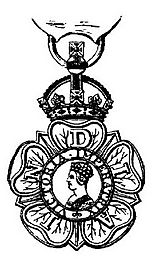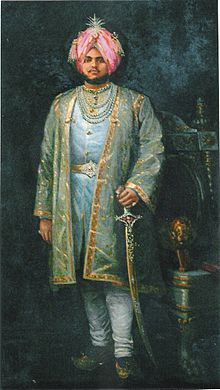Order of the Indian Empire facts for kids
Quick facts for kids Order of the Indian Empire |
|
|---|---|

The special badges of The Most Eminent Order of the Indian Empire
|
|
| Awarded by the Queen of the United Kingdom | |
| Type | Special award |
| Motto | IMPERATRICIS AUSPICIIS |
| Awarded for | At the monarch's pleasure |
| Status | Not awarded since 1947 Dormant order since 2010 |
| Sovereign | Her Majesty Queen Elizabeth II of the United Kingdom |
| Grades | Knight Grand Commander (GCIE) Knight Commander (KCIE) Companion (CIE) |
| Precedence | |
| Next (higher) | Order of St Michael and St George |
| Next (lower) | Royal Victorian Order |
The ribbon for the Order of the Indian Empire |
|

The Most Eminent Order of the Indian Empire was a special award, or "order of chivalry". It was created by Queen Victoria in 1878. This award was given to people who did important work for the British Empire in India.
The Order had three levels of members:
No new people have received this award since 1947. That year, India became independent from British rule. The last person who was a member of this order passed away in 2010. This means the order is now "dormant," or inactive.
The motto of the Order is Imperatricis auspiciis. This is Latin for "Under the auspices of the Empress." It refers to Queen Victoria, who was the first Empress of India. This Order was a junior British award connected to India. The more senior award was The Most Exalted Order of the Star of India.
History of the Order
The British government started this Order in 1878. It was a way to honor British and Indian officials who served in India. At first, the Order had only one level, called Companion.
In 1887, a second level, Knights Commander, was added. The British wanted this Order to be less exclusive than the older Order of the Star of India. This meant more people could receive the Order of the Indian Empire.
On February 15, 1887, the Order officially became "The Most Eminent Order of the Indian Empire." It then had two levels: Knights Commander and Companions. Many important people became Knights Commander at this time.
Then, on January 5, 1888, the Order grew again. A third, highest level was added: Knight Grand Commander. Seven people were given this top award. These included members of the Royal Family, like The Prince of Wales.
The highest level in most British awards is "Knight Grand Cross." But for the Indian awards, "Knight Grand Commander" was chosen. This was done to avoid using the word "Cross," which has a Christian meaning. This was important because many Indian members were not Christian.
Awards for both the Order of the Indian Empire and the Order of the Star of India stopped after August 14, 1947. Even though no new awards are given, the Orders have never been officially ended. Queen Elizabeth II is still considered the Sovereign of the Orders today. There are no living members left.
The last Grand Master of the Order was Louis Mountbatten. He was a very high-ranking naval officer and died in 1979. The last living Knight Grand Commander (GCIE) was Chithira Thirunal Balarama Varma, the Maharaja of Travancore. He passed away in 1991. The last Knight Commander (KCIE) was the Maharaja of Dhrangadhra, who died in 2010. The last Companion (CIE) was Ronald Brockman, who died in 1999.
Some fictional characters in books also received this award. For example, Purun Dass and Harry Paget Flashman in famous stories were Knights Commander.
How the Order was Organized
The British King or Queen was the head of the Order. They were called the Sovereign. The next highest rank was the Grand Master. This role was always held by the Viceroy of India. The Viceroy was the highest British official in India.
When the Order started in 1878, it only had the Companion level. There was no limit to how many Companions there could be. In 1887, the Knights Commander level was added, with a limit of 50 members. The Companions level still had no limit. The next year, the Knight Grand Commander level was added, with a limit of 25 members.
British officials and soldiers could receive the award. Also, rulers of Indian Princely States could be appointed. Usually, the rulers of the most important states received the Order of the Star of India. The Order of the Indian Empire was for other important rulers.
Interestingly, women could not usually be members of the Order. However, female rulers of Indian states could join. They were called "Knights" instead of "Dames" or "Ladies." Some rulers from other Asian and Middle Eastern countries also received this award.
Images for kids
-
Maharaja Thakore Shri Sir Bhagwatsinhji Sagramji Sahib Bahadur, Maharaja of Gondal GCSI, GCIE, in a 1911 photograph, during his visit to London for the coronation of King George V. He is wearing the mantle, collar and star of a Knight Grand Commander of the Order of the Indian Empire.
-
Photo of Sir Mokshagundam Visvesvarayya's badge
See also
 In Spanish: Orden del Imperio de la India para niños
In Spanish: Orden del Imperio de la India para niños






